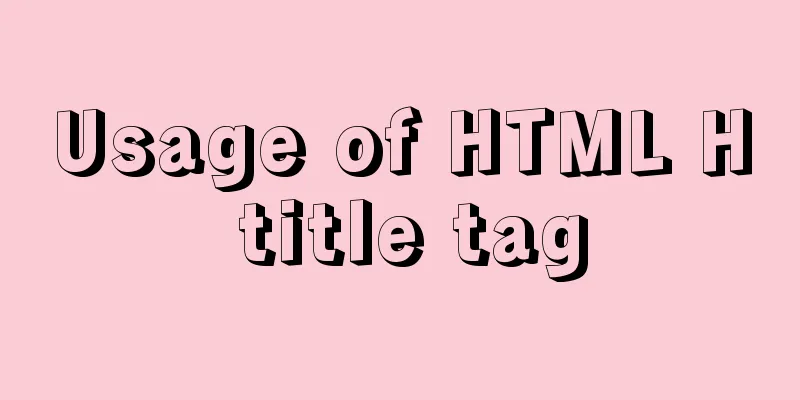Usage of HTML H title tag

|
The usage of H tags, especially h1, has always been a controversial issue and is also an issue worthy of our study. I wrote this article based on the experience of predecessors and my own understanding of H tags. I hope it will be helpful to everyone. What is an H tag? W3C states that h1-h6 tags define headings. h1 defines the largest heading. h6 defines the smallest heading. h1, h2, h3, h4, h5, h6, as title tags, in descending order of importance. I think it is necessary to follow this principle. It can make the hierarchical relationship of the page clearer, allow search engines to better crawl and analyze the subject content of the page, and so on. For better understanding, please see the following code: < body > < h1 > First level title </ h1 > < p > Paragraph </ p > < div > < h2 > Secondary Title </ h2 > < p > ... </ p > < div > < h3 > Level 3 heading </ h3 > < p > ... </ p > < div > < h4 > Level 4 heading </ h4 > < p > ... </ p > </ div > </ div > </ div > </ body > The default styles of browsers also decrease in importance, with font sizes decreasing from h1 to h6. The styles in different browsers are slightly different. Due to these differences, we usually use CSS to unify them in the layout. How do you use it? Now many websites (including Taobao, Sina, Sohu and other well-known websites) like to use h1 in their logos, as shown in the figure:
It makes sense that everyone uses it this way, and it actually has many advantages: it summarizes the content of the entire page, and the LOGO is very close to the body, which makes it easier for search engines to crawl the topic as quickly as possible. It is also more accurate in terms of semantics. Of course, not all websites use h1 in their logos. NetEase’s usage is a special example:
NetEase sets the display:none style for h1 to make it hidden. This not only solves the problem of not knowing where to put h1, but also plays a role in SEO optimization, killing two birds with one stone. The h1 of Tencent’s homepage is the headline news, as shown in the picture:
From the above examples, we can see that the usage of h1 on various websites is different. So where should h1 be placed? It's always a controversial question, but I don't think there is an absolute answer as to where to put it. I think it should be considered comprehensively based on factors such as the web page's positioning, type, and user search habits. For example, for a news website, you can put h1 on the headlines; for a comprehensive portal website, put h1 on the LOGO; if it is a company website, you can also put h1 on the LOGO, because users generally like to search for the company name when searching for a company; if there is a website slogan, you can also put h1 on the slogan, which is also a good choice. In short, it is best to choose the one that suits you best. Regarding h2, I generally like to use it in the large column of the homepage, as shown in the figure:
For content pages, I prefer to use h2 for article titles and h3 for column titles, as shown in the figure:
h3 is mostly used for column titles, as shown in the figure:
The H tag used on the homepage of the Nongxintong product not only has a clear hierarchical relationship, but also highlights the importance of product content, which is also very beneficial to search engines. The following example is also very interesting, as shown in the figure:
The column title uses h2, and the news title uses h1. If we talk about the hierarchical relationship, their order is reversed, but it is not wrong. When actually using the H tag, we can also define it according to the importance of the content. Therefore, only by mastering the basic theory and applying it flexibly can its effect be maximized. From the above examples, it is not difficult to see that the usage of H tags is very flexible and is not limited to these few usages. We only need to follow the principle of decreasing importance when using them. The same applies to h4-h6. Summarize some Based on the understanding and application of H tags by reference materials, front-end production experts, well-known websites, etc., I have summarized the following specifications, hoping to provide some reference value for everyone. h1 level title It represents the most important thing, and its position in the page is as important as that of keywords. It is usually used in website titles or headlines. Some large websites also use it in their logos. Although multiple h1 codes can be written, they are actually semantically unique. It is best if the h1 title appears only once or not at all on a page. h2 secondary title It mainly appears in the article titles and column titles of the main content of the page. The three-column structure is generally in the middle, and the two-column structure is generally on the important side. Can be used with h3. h3 level 3 heading Usually the sidebar of the main page. h4 is its auxiliary and does not appear frequently. The page hierarchy cannot be too deep, so h4, h5, and h6 generally appear less frequently. |
<<: 4 Practical Tips for Web Page Design
>>: How to reset MySQL root password
Recommend
MySQL case when usage example analysis
First we create the database table: CREATE TABLE ...
Solve the docker.socket permission problem of vscode docker plugin
Solution: Kill all .vscode related processes in t...
Docker /var/lib/docker/aufs/mnt directory cleaning method
The company's service uses docker, and the di...
Tutorial on installing mysql under centos7
Recently, I plan to deploy a cloud disk on my hom...
Centos7.5 configuration java environment installation tomcat explanation
Tomcat is a web server software based on Java lan...
Implementation of Docker to build private warehouse (registry and Harbor)
As more and more Docker images are used, there ne...
JavaScript implements double-ended queue
This article example shares the specific code of ...
Vue example code using transition component animation effect
Transition document address defines a background ...
Windows 2016 Server Security Settings
Table of contents System update configuration Cha...
Eight rules for effective web forms
If you're collecting information from your us...
The actual process of implementing the guessing number game in WeChat applet
Table of contents Function Introduction Rendering...
Detailed explanation of the idea of querying the difference between hourly data and last hourly data in MySQL
1. Introduction The requirement is to obtain the ...
js version to realize calculator function
This article example shares the specific code of ...
Linux performance monitoring tool nmon installation and usage tutorial analysis
1. Introduction to nmon Nmon (Nigel's Monitor...
Detailed steps to store emoji expressions in MySQL
Caused by: java.sql.SQLException: Incorrect strin...



















